When to Increase the Duration of Your Pet's Yoga Session
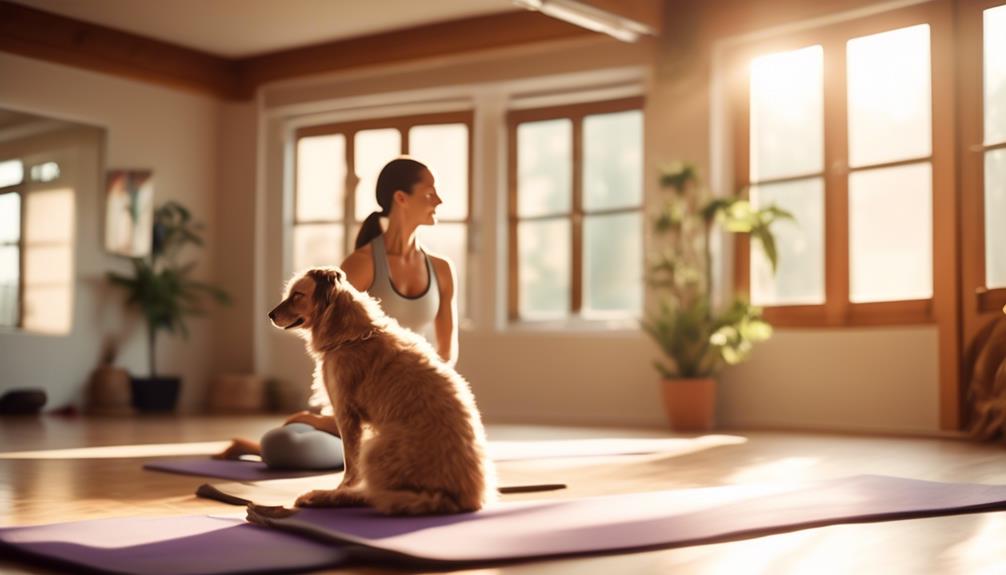
Signs that it's time to increase the duration of your pet's yoga session include:
- Increased flexibility
- Improved focus
- Enhanced strength
- Positive behavioral changes
- Feedback from their yoga instructor.
Key Takeaways
- Increased flexibility, improved focus, enhanced strength, and positive behavioral changes are signs of progress and readiness for increased duration in your pet's yoga sessions.
- Increased flexibility and range of motion in your pet can lead to benefits such as increased agility, reduced risk of injury, enhanced quality of life, and the ability to perform physical activities without limitations.
- Improved focus and concentration in your pet can result in attuned minds and bodies, increased mindfulness, improved body awareness, better ability to block out distractions, and a deeper understanding of their physical capabilities.
- Enhanced strength and stamina in your pet can lead to benefits such as muscle building, improved flexibility, breath control, increased endurance, and the ability to sustain physical activities for longer periods.
Signs of Progress in Your Pet's Yoga Practice
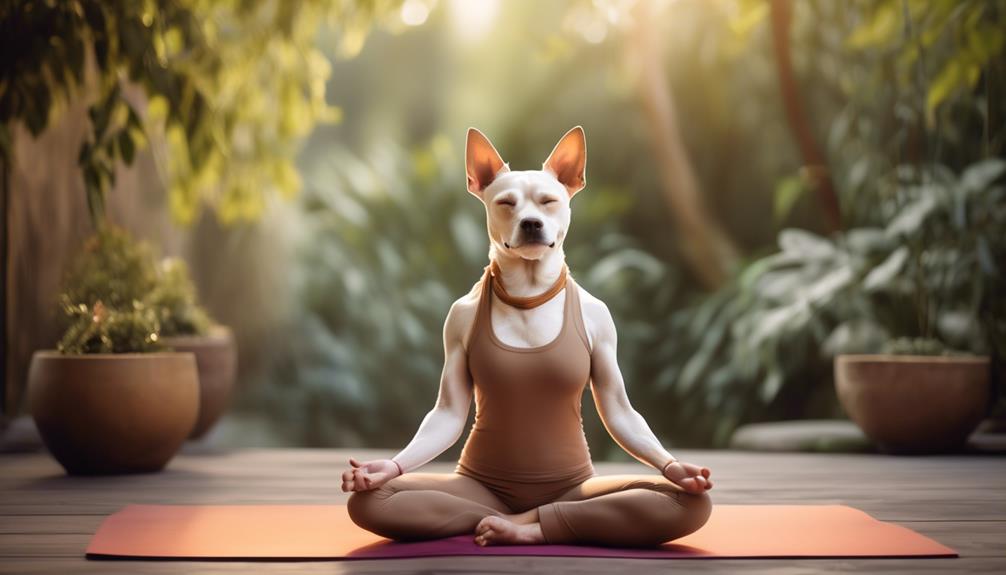
As your furry friend continues their yoga practice, you may notice certain signs of progress that indicate their growth and development in this ancient art. One of the most evident signs of progress is improved balance. Just like humans, pets can struggle with balance at the beginning of their yoga journey. However, as they continue to practice, you'll observe that they become more steady and stable in their poses. Their ability to hold challenging positions without wobbling or falling over is a clear indication of their improved balance.
Another sign of progress in your pet's yoga practice is increased relaxation. Yoga is known for its calming effects on the mind and body, and this applies to our furry friends as well. As your pet becomes more familiar with the practice, you might notice them becoming more relaxed during and after their sessions. They may appear more at ease, with a sense of tranquility radiating from them. This increased relaxation isn't only beneficial for their overall well-being but also a sign that they're truly embracing the practice of yoga.
These signs of progress in your pet's yoga practice are encouraging and show that they're reaping the benefits of their dedication. It's important to acknowledge and celebrate these milestones as they continue to grow and develop in this ancient art.
Increased Flexibility and Range of Motion
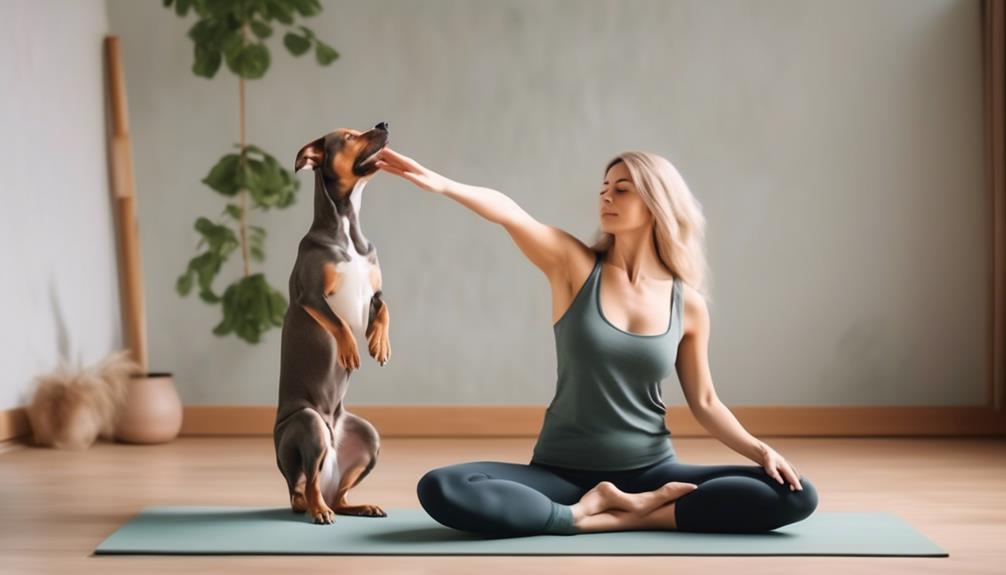
After observing improved balance and increased relaxation in your pet's yoga practice, it's time to explore the next exciting sign of progress: their enhanced flexibility and range of motion. This increased flexibility not only allows your pet to perform yoga poses with more ease and grace, but it also brings about a host of other benefits.
Here are three ways in which increased flexibility and range of motion can positively impact your pet's overall well-being:
- Increased Agility: With improved flexibility, your pet will be able to move more freely and swiftly. Their joints will have a greater range of motion, enabling them to perform agile movements without discomfort or restrictions. This increased agility can enhance their performance in various physical activities, such as playing fetch, running, or participating in agility training.
- Reduced Risk of Injury: Flexible muscles and joints are less prone to strains, sprains, and other injuries. By regularly practicing yoga and increasing their flexibility, your pet will develop stronger muscles and more resilient connective tissues. This, in turn, lowers their risk of getting injured during physical activities or everyday movements.
- Enhanced Quality of Life: When your pet has greater flexibility and range of motion, they can enjoy a higher quality of life. They'll be able to engage in their favorite activities without pain or limitations. Whether it's jumping, climbing, or simply stretching, increased flexibility allows your pet to fully embrace their natural range of movements and experience a greater sense of freedom and joy.
Improved Focus and Concentration
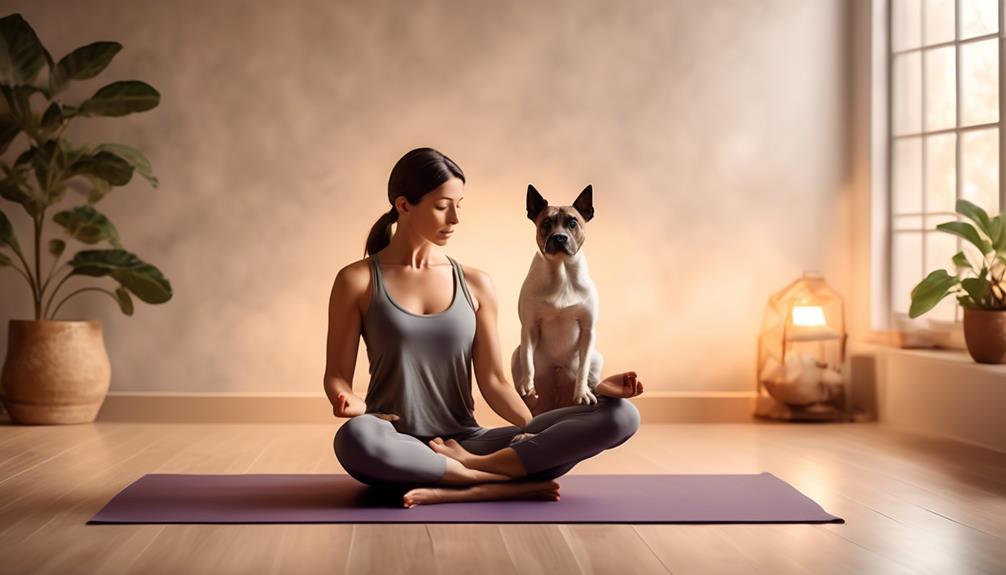
With their increased flexibility and range of motion, your pet's yoga practice also brings about a notable improvement in their focus and concentration. As they engage in different poses and movements, their minds become more attuned to their bodies, resulting in increased mindfulness and improved body awareness.
Yoga requires a level of concentration and mental presence. Pets who regularly participate in yoga sessions develop the ability to focus their attention on their breath and movements. This enhanced focus allows them to better block out distractions and fully immerse themselves in their practice.
Furthermore, yoga helps pets cultivate a sense of mindfulness. They become more aware of their bodies and the sensations they experience during each pose. This heightened body awareness allows them to make subtle adjustments to their alignment and posture, leading to a deeper understanding of their physical capabilities.
Improved focus and concentration not only benefit your pet's yoga practice but also extend to other areas of their life. They become better at following commands, learning new tricks, and even interacting with their environment. By increasing the duration of your pet's yoga sessions, you provide them with more opportunities to strengthen these cognitive skills and deepen their connection between mind and body.
Enhanced Strength and Stamina
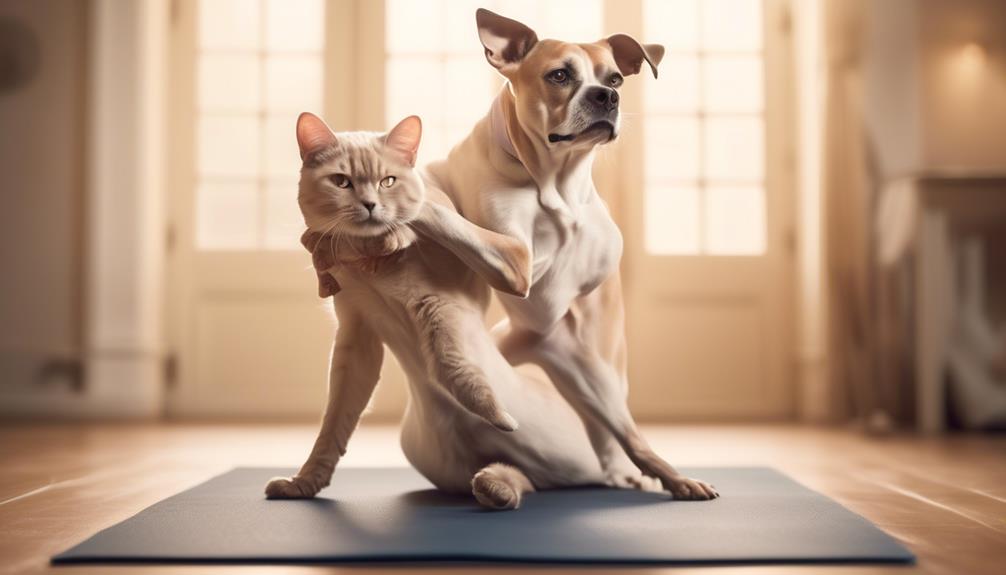
Pets who develop enhanced focus and concentration through their yoga practice also reap the benefits of increased strength and stamina. As they continue to engage in regular yoga sessions, their endurance and physical development improve significantly.
Here are three ways yoga enhances their strength and stamina:
- Muscle Building: Yoga poses require pets to engage various muscle groups, promoting muscle growth and overall strength. As they hold poses like downward-facing dog or plank, their muscles are challenged, leading to increased strength over time.
- Improved Flexibility: Yoga helps pets improve their flexibility, allowing them to move more freely and with greater ease. This increased range of motion helps prevent injuries and enhances their overall performance during physical activities, leading to improved stamina.
- Breath Control: Yoga emphasizes proper breathing techniques, teaching pets to take deep breaths and control their breath flow. This practice enhances their lung capacity, oxygen intake, and overall endurance. With improved breath control, pets can sustain physical activities for longer periods without feeling fatigued.
Positive Behavioral Changes
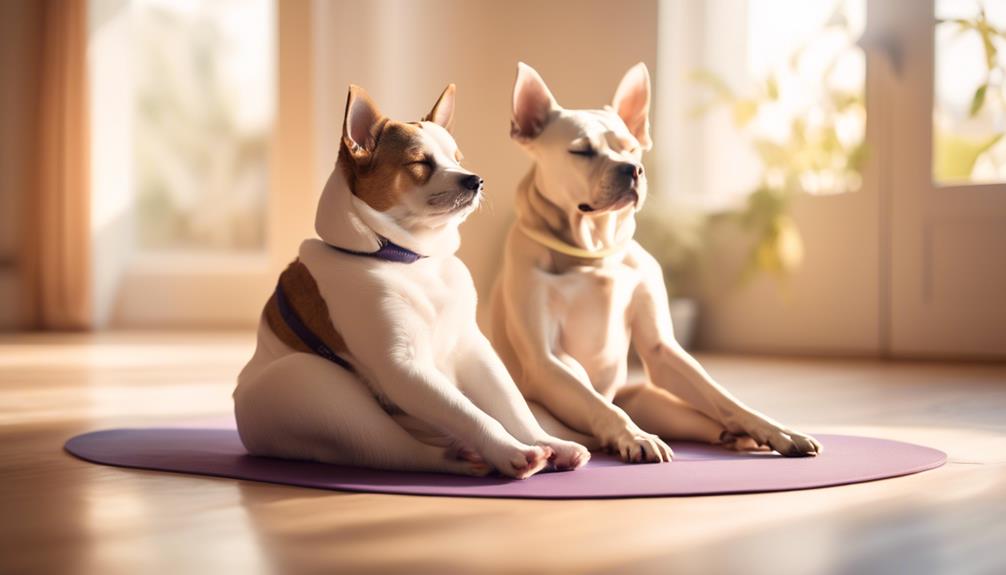
Engaging in regular yoga sessions can lead to positive behavioral changes in pets, as they learn to find inner calm and balance through the practice. The increased calmness and reduced anxiety that come with regular yoga sessions can have a profound impact on a pet's behavior.
Here is a table that outlines some of the positive behavioral changes that pets may experience through yoga:
| Positive Behavioral Changes | ||
|---|---|---|
| 1. Increased Calmness | 2. Reduced Anxiety | 3. Improved Focus |
| 4. Better Self-Control | 5. Enhanced Emotional Regulation | 6. Decreased Aggression |
| 7. Heightened Bonding with Owners | 8. Improved Sleep Patterns | 9. Increased Confidence |
| 10. Reduced Destructive Behavior | 11. Enhanced Socialization Skills | 12. Improved Problem-Solving Abilities |
Regular yoga sessions help pets develop a sense of inner peace and tranquility, which translates into increased calmness in their daily lives. This newfound calmness allows them to better manage stressful situations and reduces anxiety levels. As a result, pets become more focused, attentive, and better able to control their impulses and emotions.
Additionally, yoga helps pets build a stronger bond with their owners. The shared experience of practicing yoga together fosters a deeper sense of connection and trust. Moreover, the practice of yoga promotes better sleep patterns, leading to improved overall well-being.
Consistent and Effortless Performance of Yoga Poses
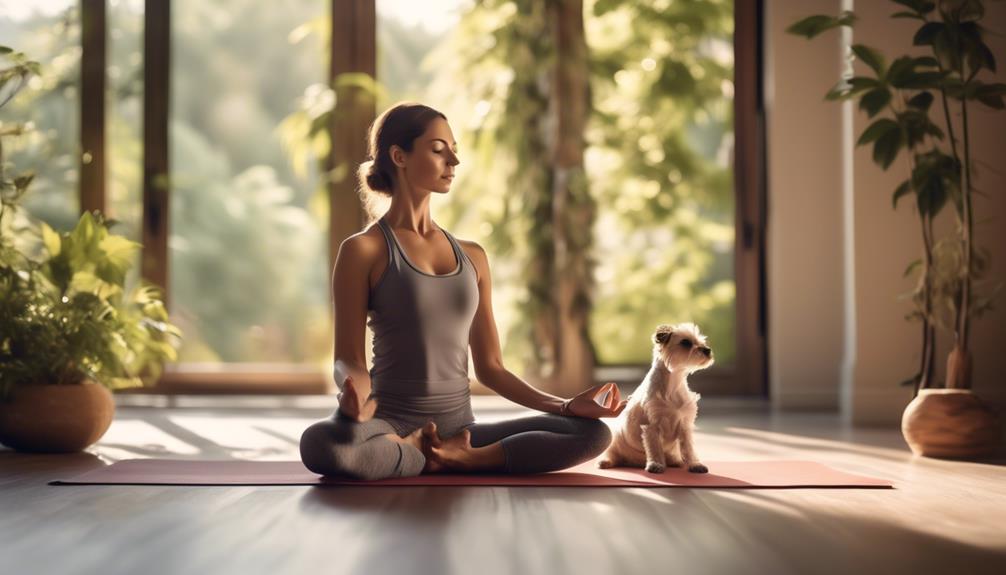
As pet owners strive to increase their furry friends' yoga session duration, it's important to focus on the consistent and effortless performance of yoga poses.
This can be achieved by increasing the duration of each pose gradually, allowing pets to maintain proper alignment throughout the practice.
Increasing Pose Duration
To achieve consistent and effortless performance of yoga poses, pet owners can gradually increase the duration of each pose, allowing their furry friends to develop strength, flexibility, and balance over time. This gradual increase in pose duration helps pets to build endurance and improve their overall yoga practice.
Here are some ways to effectively increase the duration of your pet's yoga poses:
- Increasing pose difficulty:
- Introduce more challenging variations of the pose to encourage your pet to hold it for longer periods.
- Use props or equipment to add complexity and engagement to the pose.
- Incorporate transitional movements between poses to keep the body active and engaged.
- Adjusting pose modifications:
- Gradually decrease the use of modifications, such as blocks or straps, as your pet becomes more comfortable and confident in the pose.
- Encourage your pet to explore deeper stretches and fuller expressions of the pose.
- Monitoring your pet's response:
- Observe your pet's comfort level and body language during the pose.
- Pay attention to any signs of fatigue or strain and adjust the pose duration accordingly.
Maintaining Proper Alignment
As pet owners gradually increase the duration of each pose, they must also focus on maintaining proper alignment to ensure their furry friends can achieve consistent and effortless performance of yoga poses. Proper alignment is crucial for the well-being and safety of pets during their yoga sessions. It helps them maintain balance, engage the right muscles, and avoid injuries. One key aspect of proper alignment is proper breathing. Encourage your pet to breathe deeply and rhythmically, which helps them relax and stay focused. Additionally, it is important to pay attention to their body positioning in each pose. To assist pet owners in maintaining proper alignment, here is a table outlining some common yoga poses for pets and the key alignment cues to keep in mind:
| Yoga Pose | Alignment Cues |
|---|---|
| Downward Dog | Straight spine, evenly distributed weight |
| Cat-Cow | Neutral spine, smooth transitions |
| Warrior | Strong legs, aligned hips and shoulders |
| Tree | Balanced weight, engaged core |
| Child's Pose | Relaxed neck and shoulders, deep breaths |
Gradual Progression in Difficulty
With a gradual progression in difficulty, pet owners can ensure that their furry friends achieve consistent and effortless performance of yoga poses, taking their practice to new heights. By gradually increasing the difficulty level of yoga poses, pets can build strength and prevent injuries.
Here are three ways pet owners can implement gradual progression in difficulty:
- Introduce variations: Start by adding slight modifications to basic poses, such as extending the duration or increasing the range of motion. This allows pets to gradually adapt to new challenges.
- Incorporate props: Introduce props like blocks or straps to enhance the difficulty level. These props can help pets deepen their stretches and engage specific muscle groups.
- Explore advanced poses: Once pets have mastered the foundational poses, gradually introduce more advanced poses. This helps pets further develop their strength and flexibility, while also preventing boredom.
Feedback From Your Pet's Yoga Instructor
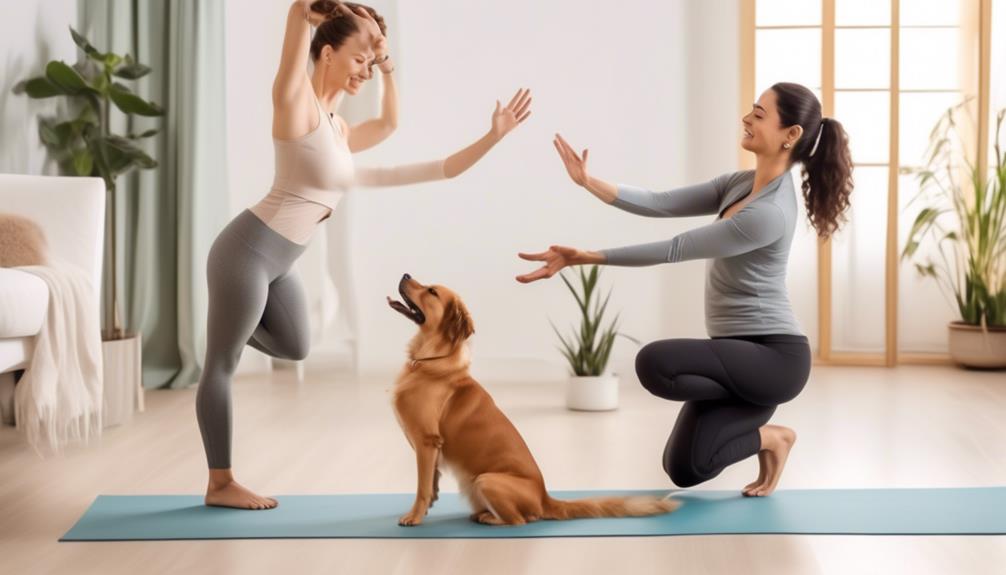
Receiving feedback from your pet's yoga instructor can provide valuable insights and help enhance their yoga practice. The instructor's expertise and observations can help improve communication between you and your pet, ensuring that you both understand and respond to each other's cues during the yoga session. Additionally, the feedback can assist in adjusting the intensity of the practice to cater to your pet's needs and abilities.
Here is a table summarizing the various types of feedback that your pet's yoga instructor may provide:
| Feedback Type | Description |
|---|---|
| Alignment | Guidance on proper positioning and alignment of your pet's body during different asanas. |
| Breathing | Tips on helping your pet maintain a steady and relaxed breath throughout the yoga practice. |
| Engagement | Suggestions on how to encourage your pet's active participation and focus during the session. |
| Modifications | Advice on modifying poses or offering alternatives to accommodate your pet's limitations. |
| Progression | Recommendations for gradually increasing the difficulty and duration of your pet's practice. |
Frequently Asked Questions
How Often Should I Increase the Duration of My Pet's Yoga Sessions?
Increasing the duration of your pet's yoga sessions should be done gradually and based on their progress. It's important to consider their comfort and physical abilities. The frequency of sessions can also be increased as they become more accustomed to the practice.
Are There Any Risks Associated With Increasing the Duration of My Pet's Yoga Sessions?
Increasing the duration of your pet's yoga sessions can have risks of overexertion. It's important to watch for signs of fatigue, such as heavy panting or difficulty breathing, and adjust accordingly to ensure their safety and well-being.
Can My Pet Practice Yoga for Too Long?
Pets can benefit from long yoga sessions, but finding the right balance is crucial. While extended practice can enhance flexibility and relaxation, it's important to consider your pet's individual needs and limitations to avoid overexertion.
How Can I Tell if My Pet Is Ready for Longer Yoga Sessions?
Pets may show signs of yoga fatigue, such as decreased energy or muscle soreness. It's important to start with shorter sessions and gradually increase duration. This allows for better adaptation and prevents overexertion, ensuring the benefits of yoga for pets.
Are There Any Specific Poses or Exercises That Can Help My Pet Progress in Their Yoga Practice Faster?
Advanced pet yoga poses can help your furry friend progress in their yoga practice faster. By incorporating challenging poses like the Downward Dog Split or the Warrior III, you can increase their strength and flexibility, paving the way for longer yoga sessions.









